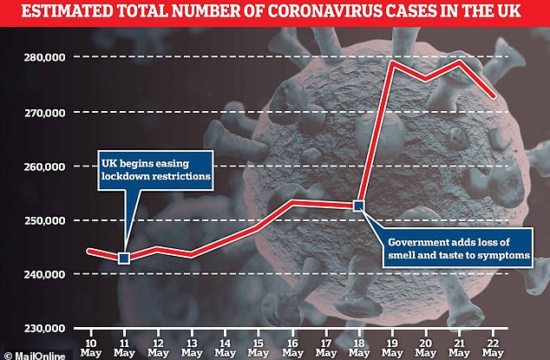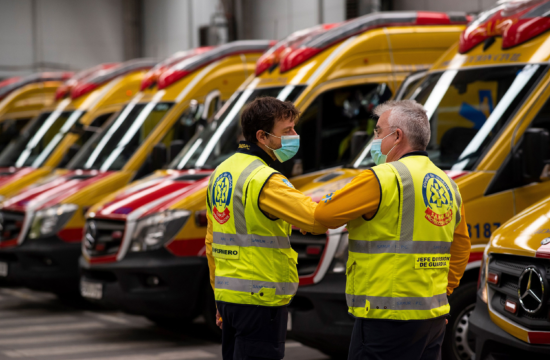Scientists have found the first clear evidence that infection with coronavirus causes the Kawasaki-like inflammatory condition affecting children.
A study of eight children admitted to a Birmingham hospital with the condition reveals they were infected with the SARS-CoV-2 virus several weeks before showing symptoms.
All of the children tested negative in the traditional lab-based test used to diagnose COVID-19 in adults but a custom-built antibody test showed that the young patients had been infected with the coronavirus and later produced antibodies to fight off the pathogen.
Doctors who treated the children say antibody tests are the only way to accurately identify the presence of the virus in children suffering from the potentially fatal hyperinflammatory condition,.
Scientists don’t know why the syndrome develops weeks after infection occurs, but believe it may be due to a severe overreaction by the body’s own immune system that makes it go haywire and can cause damage to the body’s own cells. A similar reaction has been seen in adults and is sometimes fatal.
A team of scientists led by Dr Alex Richter and Professor Adam Cunningham of the University of Birmingham studied eight young patients who were admitted to hospital between April 28 and May 8.
Lab tests (called PCR tests) are extremely reliable — and are used to identify COVID-19 and also to screen healthcare workers — these came back negative for all eight individuals.
Professor Adam Cunningham, said ‘The PCR picks up the presence of the virus itself, so the virus needs to be present at the site in the throat where the throat swab sample is taken from”, but ‘If you clear the infection then there will not be virus there to detect.”
‘In response to infections, we often make antibodies, and these are usually detectable from 14 days after the first time you are infected. ‘These antibody responses often persist in the body for months and often many years afterwards.’
The average age of the children admitted to hospital was nine years old and five of the patients were boys.
Chloe Knight, 22, revealed her two-year-old son, Freddie Merrylees (pictured), became ill just before the lockdown and was ‘like a zombie’ due to Kawasaki disease. The youngster had a rash on his body, a high temperature, red eyes and struggled to eat and drink
Seven of the patients showed symptoms of both hyperinflammation and Kawasaki disease.
One of the patients was expressing symptoms of hyperinflammation as well as some signs of toxic shock syndrome.
The mysterious and dangerous condition is being described by top medical professionals as very rare and symptoms can include fever, abdominal pain, rashes and red lips and eyes.
A very small group go into shock, in which the heart is affected, and they may get cold hands and feet and have rapid breathing.
Of the eight children treated in Birmingham and studied as part of this landmark research, all patients had fever and at least one gastrointestinal symptom such as abdominal pain, vomiting and diarrhoea.
Six of the patients required admission into paediatric intensive care due to heart-related issues and low blood pressure brought on by the disease.
All showed positive signs after treatment and have since been discharged from ICU.
Due to the reports in the media and claims from leading advisers and prominent politicians that this condition may be linked to the coronavirus pandemic, the researchers took blood samples for analysis from all eight children.
They then developed a custom antibody test with the help of researchers at the University of Southampton.
The test involves making an artificial copy of a key protein on the surface of the coronavirus which looks like a spike.
This unique ‘spike’ is a key identifier of the killer virus and was first revealed in detail by Professor Max Crispin of the University of Southampton.
He modelled the protein’s surface spikes and this has allowed his team to produce an almost exact copy of the spike.
In the Birmingham hospital, this artificially created version of the protein spike was mixed with blood samples from the patients.
The researchers saw that some antibodies in the blood of the children bound to the spike, in the same way they would if the virus itself was invading.
In the tests, researchers looked to see which of three different immunoglobulins (the technical name for an antibody) – IgG, IgA and IgM – locked onto the imitation virus.
A positive IgM reading in the tests indicates a recent infection whereas a positive reading for IgG and IgA shows an older infection, the scientists say.
The children in the Birmingham hospital had no IgM antibodies but did have IgG and IgA antibodies, showing that they were infected with SARS-CoV-2 several weeks previously.
This time delay is the reason the PCR test did not detect the infection, the researchers say.
‘IgM was not detected in children, which contrasts with adult hospitalised adult COVID-19 patients of whom all had positive IgM responses,’
‘For antibody responses, IgM responses develop first, before eventually waning and IgG responses dominating thereafter,’
– suggesting infection weeks or even months previously. ‘
This antibody test is conducted in a laboratory and is not a portable test. It is also fundamentally different to the test approved by the government today, which is manufactured by Roche. Roche’s method uses a nucleoprotein to mimic the SARS-CoV-2 virus, not the viral spike.
‘Using the native-like viral spike for antibody testing is proving a highly sensitive way of detecting exposure to SARS-CoV-2,’
The researchers say their research shows that the only way to diagnose patients with symptoms of severe inflammatory syndrome who have tested negative for the PCR is via antibody testing.
Dr Cunningham says: ‘In our study, none of the children were positive by PCR, yet all of the children were positive by antibody testing.
‘This may mean that the disease developed after the kids have already cleared the virus. If so, then serology may be more useful diagnostically for kids who are PCR negative. What the antibody test tells us is that these children have definitely been infected with SARS-CoV-2 at some time in the past, which will hopefully help doctors make decisions on how to treat these patients. Ultimately, both PCR and antibody testing have overlapping roles to play in diagnosing this syndrome. Really excitingly, the detection of the antibodies may also provide clues on how this syndrome develops.’
As a result of their findings, the researchers suggest changing the definition of PIMS-TS, as the Kawasaki-like condition is now known.
‘Since all patients were positive serologically, it may be worth considering amending the definition of PIMS-TS so that TS is not just “temporally associated with SARS-CoV-2 pandemic”, but “triggered by SARS-CoV-2 infection”,’
the researchers conclude in their study.
By Joe Pinkstone for MailOnline




